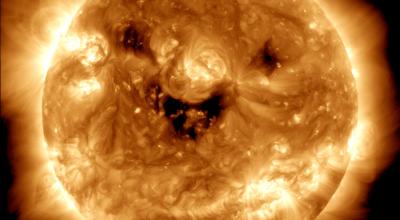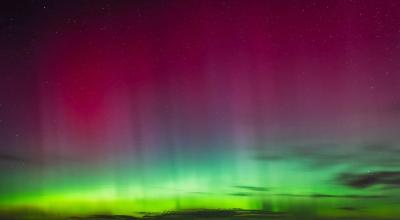The space weather that is responsible for breathtaking Southern Lights can also impact Australian communities.
Triggered by turbulent solar activity, intense space weather has the potential to disrupt critical technologies, infrastructure, and sectors.
Taking the temperature
In 2022, the Bureau of Meteorology’s Australian Space Weather Forecasting Centre (ASWFC) was established as a vital space weather capability for the country.
Dr Kate Brand manages a team of space weather forecasters at ASWFC in Adelaide, South Australia. Her team provides a round-the-clock service to assess space weather events, and their potentials impacts on Australia’s security and Australians’ lives.
In this interview, Kate briefly discusses ASWFC’s unique role in being the nation’s official source for space weather forecasts, alerts and warnings.

Space weather is primarily driven by the Sun
Solar events that cause space weather impacts include solar flares, coronal mass ejections and particle radiation events.
Why does space weather need to be monitored?
Space weather is a hazard that impacts many critical sectors, such as the space sector, but also aviation, energy, defence, telecommunications and more.
In addition, satellite-based data, including earth observation and space weather data, are crucial for weather prediction, climate monitoring, and disaster management, enhancing the Bureau of Meteorology’s ability to deliver accurate and timely services.
What’s the history of space weather forecasting in Australia?
Australia's earliest ventures into space weather started in 1947, with the advent of the Ionospheric Prediction Services (IPS), primarily to facilitate high-frequency (HF) communications to destinations around the world, such as the United Kingdom.
By the 1990's, the service had evolved well-beyond ionospheric support for HF, to provide space weather forecasts, warnings and alerts.
Eventually, the IPS joined the Bureau in 2007, and culminated with the opening of the ASWFC in October 2022.
From which locations does the Bureau of Meteorology track space weather?
ASWFC is based in Adelaide and it's here that we monitor data and observations of the Sun, and Earth's ionosphere and magnetosphere. However, the instruments acquiring these data include ground-based instruments across Australia and Antarctica, along with internationally owned satellite-based instruments.

Space weather impacts and extremes
Learn more about how solar flares and storms can be a hazard to Australian communities.
Have there been any instances where space weather has impacted Australian communities?
The largest geomagnetic storm on record is the Carrington Event, which occurred in 1859. Reports show that auroras during this time reached northern Queensland. Fortunately, reliance on technology was slim in those days, so impacts were restricted to telegraph poles (some even caught alight).
More recently, in May 2024 we had the first G5 geomagnetic storm in 21 years. We heard reports of impacts to positioning, navigation and timing (PNT), aviation and satellite operations to name a few.
ASWFC uses a global 'G-scale' to measure geomagnetic activity, which refers to fluctuations in the Earth’s magnetic field. This G-scale ranges from G1 (minor) to G5 (extreme).
Understanding space weather conditions is important all day, every day, whether there is a storm or not, to understand conditions of the ionosphere and magnetosphere for purposes such as HF, satellite communications and PNT.
Any innovative ways the Bureau of Meteorology investigates changes in the space environment?
In 2022 the Bureau launched (pardon the pun!) its Australian Spaceflight Weather Service.
This service supports both civilian and military purposes, combining space weather and terrestrial weather into one support service for the space sector, providing support for launch, re-entry, satellite operations, satellite anomaly attribution, and spaceport site selection.
Could you share a fact about the ASWFC that is not common knowledge?
We represent the Regional Warning Centre for Australia, working with 23 other countries in the International Space Environment Service. We also support the International Civil Aviation Organisation's global space weather advisory service, along with 15 other countries.
Why does space matter to you?
Having moved into the 'space' area three years ago, my awareness has increased drastically as to how integral space is to all parts of our lives. I feel personally invested in my role at the Bureau, to play a small part in safeguarding space, and ensuring our increased utilization of, and dependency on, space is sustainable.

Space has the Answers
The Agency's video series highlights how space technologies are helping Australia confront some of our biggest challenges.
